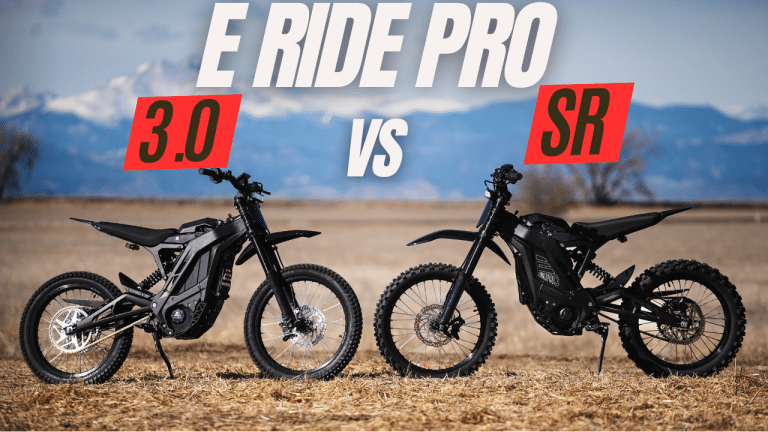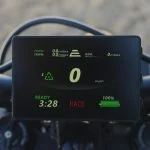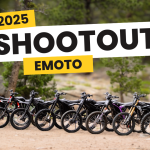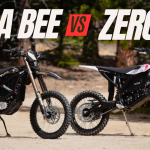The 2025 E Ride Pro SR and the E Ride Pro SS 3.0 are two new popular bikes on the eMoto scene. Both the E Ride Pro SR and SS 3.0 share the same basic platform and styling. From a glance, they look nearly identical, but under the skin there are key differences that affect their weight, power, and ride characteristics. The SR features several upgrades like a beefier frame and higher-output powertrain, while the SS 3.0 remains a potent and lighter sibling. In this comparison, we’ll break down every major difference – and the similarities – to help you decide which bike fits your riding style.
| Specification | E Ride Pro SR (2025) | E Ride Pro SS 3.0 (2025) |
|---|---|---|
| Price (USD) | $5,599 | $4,999 |
| Weight | 183 lbs (83 kg) | 167 lbs (76 kg) |
| Peak Power | 25 kW (33.5 hp) | 15.8 kW (21.2 hp) |
| Rated Power | 10 kW (13.4 hp) | 6 kW (8.0 hp) |
| Battery | 72V 50Ah (3600 Wh) | 72V 50Ah (3600 Wh) |
| Top Speed (claimed) | 70 mph (113 km/h) | 62 mph (100 km/h) |
| Range (claimed) | ~62 miles @ 25mph (93+ miles @ 15mph) | ~64 miles @ 25mph (100+ miles @ 15mph) |
| Wheel/Tire Size | Front 19″ (80/100-19), Rear 18″ (100/90-18) knobbies | Front 19″ (2.75-19), Rear 18″ (3.00-18) knobbies |
| Suspension | FastAce adjustable fork & shock (compression/rebound adj.) | FastAce adjustable fork & shock – Same as SR |
| Ride Modes | 3 modes: Eco (Street), Sport, Race + Reverse | 3 modes: Eco, Sport + Reverse |
| Regenerative Braking | Yes – adjustable + thumb brake lever | Yes – adjustable |
| App Connectivity | Yes – Bluetooth tuning via mobile app | Yes – Bluetooth tuning via dongle (coming soon) |
| Frame | Reinforced “beefed-up” frame, subframe & swingarm | Standard frame, subframe & swingarm (lighter) |
| Seat | Extended-length seat (coming soon) | Standard seat length/shape |
| Brakes | 4-piston hydraulic calipers, 220mm rotors (front & rear) – Same on both | 4-piston calipers, 220mm rotors (same as SR) |
E Ride Pro Weight
One of the first differences you’ll feel between the SR and the SS 3.0 is the weight. The Pro SR weighs in at about 183 lbs (83 kg), whereas the Pro SS 3.0 is around 167 lbs (76 kg). That’s a difference of roughly 16 pounds (7 kg) in the SR’s favor – or rather, disfavor, depending on how you look at it.
Why the extra heft on the SR? Mostly it comes from the beefed-up frame and higher-spec components (which we’ll talk about below). Despite the SR’s added weight, it’s still relatively lightweight for an electric dirt bike with this level of power. Our team felt the SR’s 183 lb mass is manageable – it strikes a balance between stability and agility in practice. The SS 3.0, being lighter, feels just a tad more flickable in tight turns, and easier to throw around if you’re doing jumps or quick direction changes. Riders coming from something like a Sur Ron or smaller e-moto will find the SS 3.0 closer in weight, while the SR’s extra pounds give it a more planted feel at speed.
If you value light weight and nimble handling, the SS 3.0 has an edge. But the SR isn’t exactly a tank either – and its other upgrades might justify the weight for many riders.
E Ride Pro Peak Power Output
Now to what (almost) everyone cares about: power! This is where the SR really distances itself. The E Ride Pro SR boasts a whopping 25 kW peak output (about 33.5 horsepower). In contrast, the E Ride Pro SS 3.0 puts out around 15.8 kW peak (21.2 hp). In nominal terms, the SR’s motor is rated ~10 kW continuous, while the SS 3.0’s is ~6 kW. That means the SR is tuned for significantly higher punch when you crack the throttle.
On the trail, this difference is very noticeable. The SR launches harder and pulls with authority all the way up to top speed. It has the kind of brutal acceleration that can loft the front wheel on demand in the higher power modes. The SS 3.0 is no slouch – 15.8 kW is still ~21 hp, well above something like a Sur Ron X – and it feels quick, but next to the SR it’s a bit more tame. Think of the SS as “plenty fast” and the SR as “hold on tight, this thing rips!”.
The SS 3.0’s power is easier to utilize fully for the average rider, and still more than enough for most trails or casual racing. High-end power junkies will gravitate to the SR for that 25 kW hit, while others might find the SS 3.0 already beyond their needs.
Battery (Capacity and Cells)
Interestingly, despite the huge gap in peak output, both the SR and SS 3.0 use the same battery capacity – a 72V, 50Ah lithium pack (~3.6 kWh). In terms of size and swap-ability, the battery packs are identical: both are removable/swappable and take roughly 3.5 hours to charge from 20% to 90% on a fast charger.
However, there is a rumored difference in the battery cell type. The E Ride Pro SR’s battery is confirmed to use Samsung 50S cells, which are high-discharge 21700 lithium cells known for good performance. The SS 3.0’s cell supplier isn’t officially advertised – it may use a different 21700 cell model or a less expensive cell. This has led to speculation that the SR’s battery can deliver higher current output more reliably, enabling that 25 kW burst, whereas the SS 3.0’s pack might not sustain those amps (hence its lower peak power). E Ride hasn’t explicitly stated the SS 3.0’s cell type, but the bikes have the same 72v 50Ah rating, so any real-world range difference comes down to weight and tuning rather than capacity.
In everyday use, both bikes have the same battery endurance potential (we’ll talk ranges in a moment). The key takeaway: battery size isn’t a deciding factor between SR and SS 3.0 – but the SR’s pack may be built to handle more abuse (current draw) thanks to those Samsung cells. For most riders, both packs will feel the same; hardcore users might appreciate the SR’s higher spec cells for longevity if pushing the bike hard or upgrading power in the future.
Wheel Size and Tire Type
Both the SR and SS 3.0 use the same wheel setup: a 19-inch front and 18-inch rear with matching hubs and rims. The key difference lies in the tires.
The SR comes equipped with aggressive knobby tires, ideal for off-road conditions and loose terrain. The SS 3.0, on the other hand, comes with E Ride Pro’s in-house dual sport tires, which are styled similarly to a Shinko 241. These tires are a more street-friendly option, offering better all-around performance if you’re riding mixed terrain—like pavement, hardpack, and dirt jumps.
While the wheel sizes are identical and cross-compatible between bikes, the difference in tires will definitely affect how each one hooks up depending on the terrain. For pure off-road grip, the SR’s knobbies have the edge. For riders who spend time on the street or smoother trails, the SS 3.0’s dual sport-style tire is a solid all-purpose pick.
Both setups are easy to swap or upgrade based on your riding needs.
Suspension
When it comes to suspension, the two bikes are twins. Both the E Ride Pro SR and SS 3.0 come equipped with the same FastAce adjustable suspension setup. That means up front you have inverted FastAce forks with full adjustability (compression and rebound damping) and preload-able springs, and a FastAce rear shock with piggyback reservoir (also compression/rebound adjustable). This is a solid mid-level suspension package – not as fancy as a KYB or WP setup from a motocross bike, but very capable for a lightweight e-moto.
Because the hardware is the same, the suspension performance is very similar on both bikes. The only difference might be in tuning: the SR is heavier, whereas the SS 3.0 is lighter, so you will want to set your suspension up accordingly.
Bottom line: suspension won’t be a deciding factor between these two – they share the same components. If you’re hitting big jumps or whoops, you’ll want to tune or possibly re-spring either bike to your needs. Out of the box, they’re comparable. That’s good news for aftermarket suspension upgrades too, as any fork/shock mods are cross-compatible.
Top Speed
According to E Ride’s claims, the Pro SR has a higher top speed – about 70 mph – whereas the Pro SS 3.0 tops out around 62 mph. In our testing, we found the SR was initially limited to 65 mph in Race mode until we unlocked its full power (it had a 90% speed limiter from the factory). After unlocking, hitting that 70 mph mark is achievable on the SR under the right conditions. The SS 3.0, on the other hand, seems to hit the low-60s mph and plateau, likely due to its power cap.
In practice, both bikes are very fast for off-road machines – 60+ mph on dirt feels insanely quick. The SR’s extra top-end might be useful if you’re racing on a long straight or trying to keep up with bigger bikes on open terrain. However, for tight trails or MX tracks, neither bike will likely hit the limiter often.
So, if you need bragging rights for the higher top speed, the SR wins here. 70 mph vs 62 mph can sound big on paper, but remember: the SR’s advantage is not just top speed, but it also has the better acceleration. For most riders, 62 mph is already more than enough off-road. But if you envision drag racing your buddy, the SR has the edge when fully derestricted.
Claimed Range
Despite sharing the same battery capacity, you’ll notice slightly different range claims for the two models. E Ride (and retailers) advertise the SS 3.0 as capable of about 64+ miles of range at 25 mph cruising, or up to 100+ miles at 15 mph. The SR is listed at roughly 62+ miles at 25 mph, or ~93 miles at 15 mph. Essentially, the SS 3.0 gets a few more miles in the ideal scenario. Why? Most likely the SR’s higher weight and tuned output cause a bit more consumption.
In real-world riding, the difference is minor. Both bikes, ridden hard in race mode, will drain their 3.6 kWh batteries in a similar time frame. In our torture test in sand, the SR managed ~16 miles on a full charge in race mode (with 16% left). Expect the SS 3.0 to be in that same ballpark (perhaps slightly more since it has less power to dump). If you ride more moderately in mixed modes, 30-40 miles of trail riding could be reasonable on either bike. Stretch it with Eco mode on the road at 15–20 mph, and hitting 60-70+ miles may be feasible on both, but we’ve never seen it.
So, range shouldn’t be a major deciding factor between SR and SS. The SS might eke out a few extra miles at low speeds due to being lighter, but the difference is not huge. Both share the same 50Ah fuel tank, so to speak. If maximum range is your goal, you’ll be managing throttle and modes the same way regardless of model. And if you pin it everywhere, both will drain faster – the SR just lets you get there faster.
App Connectivity and Bluetooth Tuning
The E Ride Pro SR is fully tunable through E Ride Pro’s Bluetooth app. Riders can adjust power output, throttle response, regenerative braking levels, and even customize how each ride mode behaves. The app also allows you to change the top speed limit, toggle sensors like the kickstand and tilt safety switches, and update the controller firmware directly from your phone. It’s one of the most complete tuning packages we’ve seen on a stock mid-power electric dirt bike, giving riders real flexibility to dial in performance for different terrain or riding styles.
The SS 3.0 comes with a Bluetooth dongle already installed, so the hardware is there, but the app-based tuning features are not yet active. That said, a software update enabling those same functions is expected soon. Once available, the SS 3.0 should have access to the same tuning options found on the SR—including power maps, regen control, speed limiter settings, and sensor toggles.
So while both bikes come ready for Bluetooth connectivity, only the SR currently supports full tuning in the app. If customizing your ride from your phone is a priority, the SR is the better option today. But the SS 3.0 is already equipped for it, and once that update drops, it’ll be just as capable.
Ride Modes
The E Ride Pro SR comes with three selectable ride modes—Eco, Sport, and Race—plus reverse. Each mode progressively increases power output and throttle response, giving riders a clear range from smooth and conservative to full performance. Eco mode is ideal for technical riding or conserving battery, Sport is a great all-around setting, and Race unleashes the full 25kW output of the SR. Reverse can be activated via a button sequence or through the Bluetooth app.
The SS 3.0, by comparison, includes only Eco and Sport modes. There’s no Race mode available on this bike, and its peak output tops out at 15.8kW. While Eco and Sport still provide solid performance—with Sport mode offering more than enough power for most trail or track situations—the lack of a third, more aggressive map means the SS 3.0 has slightly less flexibility out of the box.
One refinement that came with the SR’s launch was an optional solution to improved throttle mapping. Early SR units had a sensitive throttle that could feel jumpy at low speeds. That’s been addressed with a pre-progammed update, and if your SR still feels overly twitchy a quick firmware update should smooth things out.
While the SR offers more tuning headroom and a third mode for advanced riders, the SS 3.0 still delivers strong performance in its two available modes. Both bikes allow easy mode switching via the handlebar display, and both support reverse once activated in the app. For riders who want the most control and highest performance settings, the SR’s third mode makes a difference—but the SS 3.0 still holds its own in everyday riding.
Price – What Does an E Ride Pro Cost?
Of course, all these differences come at a cost – literally. The E Ride Pro SR is more expensive than the SS 3.0. As of this writing, the SR is listed around $5,599 USD, whereas the SS 3.0 goes for about $4,999 USD. That’s roughly a $600 price gap between the two. In percentage terms, the SR is about 12% more expensive than the SS.
What do you get for that extra $600? As we’ve outlined: ~9 kW more peak power, a reinforced frame, a longer seat, tunability, tires and a few other upgrades (plus some minor bling like a CNC sprocket). Everything else – battery capacity, suspension, wheels, etc. – is the same. Whether that price difference is “worth it” depends on your priorities. If you crave performance and plan to push the bike’s limits, $600 is a small premium for the top-spec model (the power alone might be worth it, considering how much controller/battery upgrades can cost in the aftermarket). On the other hand, if you’re more of a casual rider or on a tighter budget, the SS 3.0 gives you almost the same package for less money, and you could use that saved $600 on gear or future mods.
Final Thoughts
Choosing between the E Ride Pro SR and SS 3.0 comes down to your priorities as a rider:
- Choose the 2025 E Ride Pro SR if you want the absolute best performance – the most power, higher top speed, and a sturdier frame for hard riding. For about $600 more, you get a bike that’s essentially race-ready out of the box, with only a slight weight penalty. The SR is ideal for riders who will push the limits, compete, or just love having the top-spec model with no regrets. It’s a “pro” model in every sense, and it definitely delivers on the hype with its 25 kW punch and upgraded build.
- Choose the E Ride Pro SS 3.0 if you value bang for your buck and a slightly lighter, more approachable ride. You’re getting 90% of the SR’s experience – same battery, same suspension, same brakes, same connectivity – at a lower cost and weight. The SS 3.0 is still a beast (15.8 kW is nothing to sneeze at) and will satisfy the vast majority of riders. If you’re trail riding from home, looking for a fast general purpose bike, or just want an electric dirt bike that outperforms most others in its class without reaching into the very high performance tier, the SS 3.0 is a fantastic choice.
The good news is you really can’t go wrong – both models are pushing the envelope of what a mid-sized electric dirt bike can do. E Ride has given us two options on the same platform: one that’s extreme (SR) and one that’s accessible (SS 3.0).









